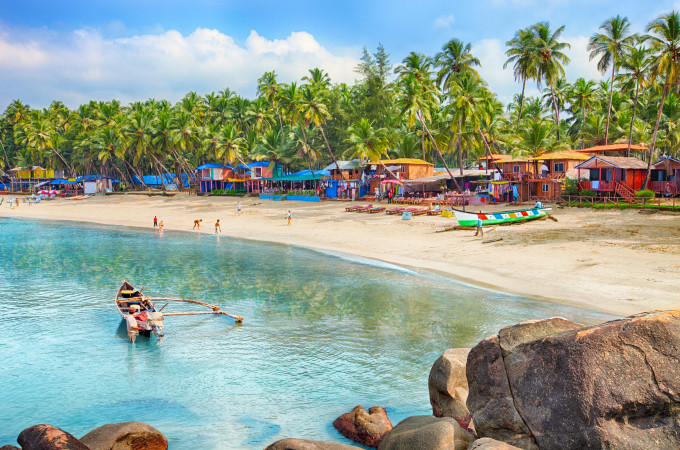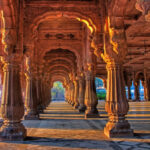Despite tremendous strides in recent decades in such modes of transportation as jets, helicopters, high-powered boats, and high-speed highways, the Indian train still remains one of the best ways to travel in India—especially for tourists.
Ever since the 16th of April, 1853 when the first 13-carriage train carried passengers between Bori Bunder (Bombay) and Thane, 21 miles away, the amazing Indian Railway network has connected and integrated a sprawling, unbelievably diverse subcontinent into one single giant whole—from the heights of the Himalayas to the shores of Kerala.
Today, with 12,617 trains and 7,717 train stations across India, some 23 million Indians travel on the Indian train network daily, making the Indian Railways by far the largest carrier on the planet. For comparison, that is equal to the entire population of Australia!
But with such a gargantuan magnitude of operations comes some understandable complexity which can be hard for visitors to unravel.
In this all-encompassing guide to trains in India, we will give you a thorough run-down of the railway system in India, how it operates, how to book tickets, the things to consider before going on a ride on the rails, the cost of travel and advice on the best routes to travel on for sightseeing.
Let us begin!
Why Choose Train Travel in India?
You haven’t really seen the real India until you have traveled on its trains.
‘Why should I travel by train when other forms of transportation are available?’ is the first question you would be asking as a tourist. The answer is simple: because it is just the best way to see India.
The Indian train is the best way to wrap your head around India and see this magnificent country outside of the tourist bubbles in its raw majestic primal form.
A journey on an Indian train is a cultural immersion experience, unlike very few experiences that you are likely to witness in India. All of India travels by train. It wouldn’t be incorrect to say that the train takes you to “the heart of the matter” in India.
As the train rhythmically chugs its way through changing landscapes, you will find the Indian train journey to be a kaleidoscopic display of Indian cultures, classes, and regional and ethnic diversity.
Since 1863 when the first train ran in India, an organic ever-evolving ecosystem of quaint little towns, and cities have erupted along the routes and stations of the Indian Railways network. Many would argue that the real India lives here.
Another reason you should travel by train in India is the prospect of witnessing a beautiful display of varying landscapes, sceneries and sights.
The Indian trains take you through the majestic golden dunes and arid deserts of the Thar Desert in Rajasthan and the rugged plains of Gujarat to the misty mountains of Himalayan bliss in Darjeeling in West Bengal, the lush-green rolling hills of tea plantations in Kerala and picturesque sandy beaches of Goa.
Many of India’s biggest landmarks —like the Taj Mahal (Agra), Red Fort, Qutub Minar, Red Fort (Delhi), City Palace, Hawa Mahal, Amber Fort (Jaipur), the Golden Temple (Amritsar), Mehrangarh Fort (Jodhpur) and Gateway of India (Mumbai)—are easily accessible by train and you can put them all in one bucket list on single or multiple route itineraries.
The Indian railway network will take you just about everywhere in India.
While we recommend a mix of trains, cars, and air travel to enjoy a well-rounded travel experience in India and see India from different vantage points on-ground and airborne, you can still traverse the entire length and breadth of the country just by traveling on the train alone.
“But Is it Safe?” How Safe Are Train Journeys in India?
Contrary to the stereotypical photographs of Indian trains swarmed by passengers in crowded railway stations, the Indian railway system has come a long way over the years in terms of quality standards, speed, efficiency, safety, and comfort.
The rail system caters to a variety of budget classes, ranging from low and mid-level budget to high-end luxury train service.
The “class” of train you choose depends on your budget and the quality and standards of service you are willing to pay for. You can count on better service and comfort in better classes of trains.
We will explain the various classes and kinds of Indian trains later, but it suffices for now to note that Indian trains are remarkably safer and accidents are at an all-time low.
Many important tourist circuits like the Golden Triangle region (Agra, Jaipur, Delhi) and popular regions like Kerala, Mumbai, and Rajasthan have special-purpose luxury train services during peak tourism months to cater to international visitors.
As with train travel anywhere else in the world, you are expected to be vigilant.
Never leave your luggage unattended. Busy railway stations may have pickpockets, so make sure your valuables are tightly strapped and tucked in
The India Railway System – What You Need to Know
Understand the Railway System First
With the 63,00 km-long network, 3rd largest in world after Russia and China, 23 million commuters carried around daily, and over 7,000 railway stations, the Indian railways is a veritable miracle. The world’s biggest employer with 1.5 million employees is also the world’s biggest carrier.
But all of this comes with some complexity. It is usually not a hop-on-and-go experience and historically the railway has been notorious with international tourists for its oddities.
But fortunately, all of this is changing with reforms and the adoption of best global practices.
You can begin by logging in to www.indianrail.gov.in. for a basic glance at the services, times, and fares for trains in India.
Another important official resource that you can look at is www.indianrailways.gov.in or download the IRCTC apps on Android or IOs. There are also third-party apps like Ixigo that you can choose for checking Indian train times on the go.
Another old-fashioned but charming way to understand the railway system in India is to purchase the iconic “Trains At a Glance” for 100 Indian rupees at a train station or bookstall.
Do not let this hassle annoy you. We guarantee that you won’t regret the time and effort you put into understanding how this system works.
Please understand that the railway system serves not just you and the foreign tourists, by a humungous 1.4 billion people, who have varying needs. So, such complexity is understandable.
Plan Out Your Itinerary in Advance
Going with the spontaneous spur-of-the-moment decisions and hopping on a train is all fun and games, but probably not the smartest choice if you value your time and comfort. We, therefore, recommend that you chalk out an itinerary and routes before you embark on a train trip to India.
Read up, research, or discuss details vis-a-vis routes, trains, and stopovers with your travel consultant.
While one shouldn’t be straitjacketed by rigid itineraries that restrict your options and do not allow you to innovate and try new things, it is also not a bad idea to have some kind of train route road map thrashed out in your head before you travel.
For example, if you are traveling in North India, it would be a sensible option to arrive at the capital Delhi and then embark on a train adventure to Agra to see the Taj Mahal, followed by a leisurely stopover in Rajasthan to see its top attractions in Jaipur, Udaipur, Jodhpur, and Jaisalmer.
Bear in mind that train tickets may sometimes sell out months in advance, so if you are looking to travel in the peak tourist season (November-March), you will have to book your routes 60-90 days in advance.
Types of Trains in India
There are different types of trains in India. Understanding differences will go a long way toward helping you plan better travel experiences.
Local and Passenger Trains
They ply local short-distance routes with frequent stopovers. Do not travel on local trains when you are travelling long distances. They make too many stops and are very slow.
Rajdhani Express Trains

Deriving their name from the Hindi word which means “capital,” the Rajdhani Express feature fast air-conditioned sleeper trains using German-designed Linke Hofmann Busch (LHB) coaches.
The Rajdhani Express covers important cities like Delhi, Mumbai, and Kolkata.
Shatabdi Express Trains

Also, air-conditioned high-speed (140km/h – 87 m/h) express trains operated by German LHB coaches, the Shatabdi trains generally run during day time on routes like Delhi-Kolkata, Delhi-Jaipur, and Delhi-Agra. Food is covered in the fare.
The Jan Shatabdi variant operates similar RHB engines but is slightly slower and cheaper than the Shatabdis.
Tejas Express Train

With a top speed of 80 m/h (130km/h), the Tejas Express operates on Delhi-Lucknow and Delhi-Goa routes. They often operate late at night. Shatabdi trains are excellent options for tourists visiting Goa and South India. You can learn more about them on this link.
http://www.totaltraininfo.com/tejas-express.php
Inaugurated by the Prime Minister of India Narendra Modi in 2017, the Teja Express along with Gatimaan and Vande Bharat Express trains is part of the plan of the Indian government to modernize train travel in India.
It boasts high-velocity air-conditioned trains, onboard Wi-Fi, charging portals, big LED screens, tea, and coffee machines. Currently operating through cities such as Delhi, Mumbai, Patna, Kanpur, Lucknow, Ahmedabad, Goa, and Chennai, the Indian Railways plans to gradually expand its routes and add new destinations to the Tejas Express.
Vande Bharat Express Trains

The Vande Bharat Express Trains are fastest in India and can operate at a top speed of 160km/h (100m/h). They run only on a few select routes like Delhi to Varanasi, and Delhi to Kolkata, and carry only 16 cars on each train.
However, their routes are being expanded and soon these trains will be plying on more routes. These are highly recommended train rides for foreign tourists.
Duronto Express

In Bengali, the word Duronto means non-stop. Introduced in 2009, the Duronto Express run—you probably guessed it!—non-stop high-speed trains between extremely long distances like Delhi-Kolkata, Delhi-Lucknow, and Mumbai-Kolkata. It is one of best trains for these routes.
They are highly recommended for long distances.
How To Book Your Indian Railways Tickets
Booking Your Train Ticket Online

High-speed trains like Duronto, Shatabdi, and Vande Bharat often sell out quickly, so you will have to book your tickets weeks in advance.
If you have planned an itinerary with a bucket list of destinations you want to see, you will be well advanced to get your tickets as well by getting your tour operator to book for you or doing it yourself online by registering at the official Indian Railways booking website www.irctc.co.in.
Be warned that the process may be drawn-out and slightly annoying, and registration process may be slightly glitchy.
The IRCTC system accepts international debit and credit cards, but tourists have occasionally reported getting their cards declined.
Another hassle-free online method is to book via a ticketing agency like www.12go.asia which sells only confirmed tickets and accepts overseas credit cards. You can pay in US dollars, Euros, Pounds, or Indian currency.
The way it works is that 12go staff manually secures your tickets using the IRCTC’s business-to-business booking system. You will receive an e-ticket. Be sure to get a photocopy of the e-ticket onboard.
The small additional markup and fee are well worth the ease.
Booking Your Train Ticket At the Station

You can also book your ticket at railway stations in India. In big metropolitans like New Delhi, Mumbai, Kolkata, and Jaipur, which get a lot of international tourists, International Tourist Bureaus offer hassle-free booking services for foreign visitors.
Be mindful that it is usually very difficult to get a last-minute confirmed train ticket at the count
The Classes On The Indian Train
Now that we know the basics about train travel in India, let us wrap our heads around the dizzying range of “classes” on Indian trains. Depending upon how you look at it, there are some 10 classes on Indian trains.
Here is how they are categorized. We begin with the high-end expensive ones with highest amenities.
Air-Conditioned First Class (AC1 or 1A)

The AC1 is usually the best and most comfortable class and is therefore the most expensive one. Usually costing twice as much as the next category (AC2), in Air-conditioned First Class you get spacious bedding berths (that convert to seats) for long-distance travel.
There are 2-berth and 4-berth compartments, which are ideal for couples and families.
Please note the Air-Conditioned First Class (AC1) is available on a handful of modern trains, and the number of AC1 seats available is usually limited. So, make sure you have your ticket booked well in advance.
Air-Conditioned 2-Tier (AC2 or 2A)

The preferred choice of the middle class, and most mid-range foreign tourists, the AC2 is found on all long-journey trains like Shatabdi, Duronto, and Rajdhani.
You get padded seats in a clean compartment with enough room for your legs. The seats are convertible to padded bunks for sleeping at night. Unlike AC1 class which are closed, AC2 are open-plan with four berths on one side and 2 on the other, with a curtain dividing the bays for privacy reasons.
Air-Conditioned 3-Tier (AC3 or 3A)
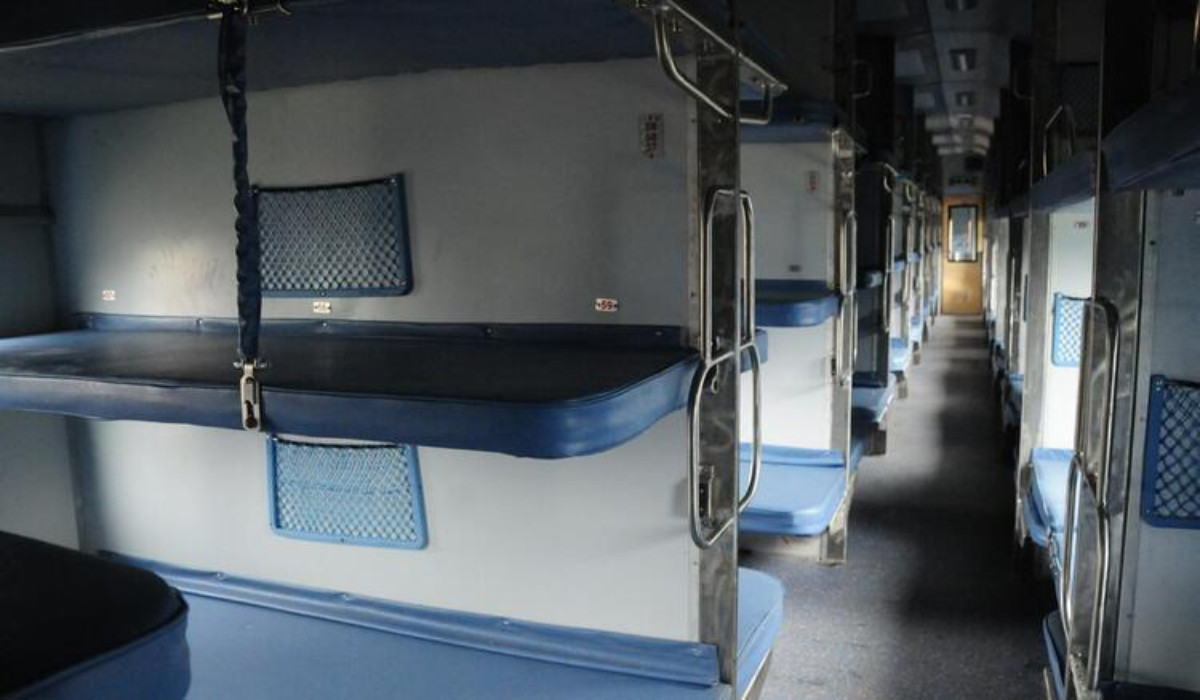
Slightly more crowded and less spacious than the AC2, and therefore cheaper, AC3 are arranged in bays of six on one side of the aisle and tow along the wall on the other side of the aisle.
Since it is more crowded, there is reduced space for comfort and less privacy.
Air-Conditioned 3-Tier Economy (3E)

Think of 3E as a more water-down and cheaper version of AC3, with 3 bunks (upper, middle, and lower) as opposed to just the 2 on AC3.
Hence the name economy. Expect reduced privacy and less comfort.
Air Conditioned Executive Chair (EC)
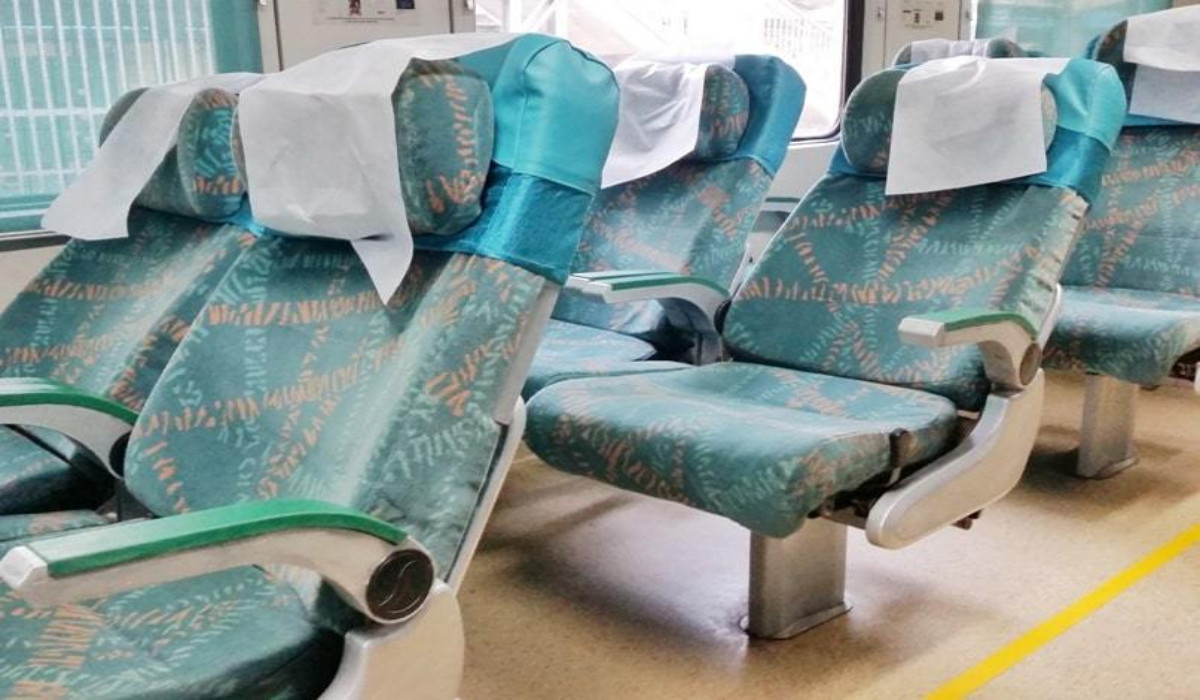
Available only on high-quality trains like Shatabdi, Vande Bharat, and Tejas, with EC you get cozy executive chairs arranged in 2+2 formations with an aisle dividing them. You get pre-packed food and drink covered in the ticket.
Executive Anubhuhti Chair (EA)
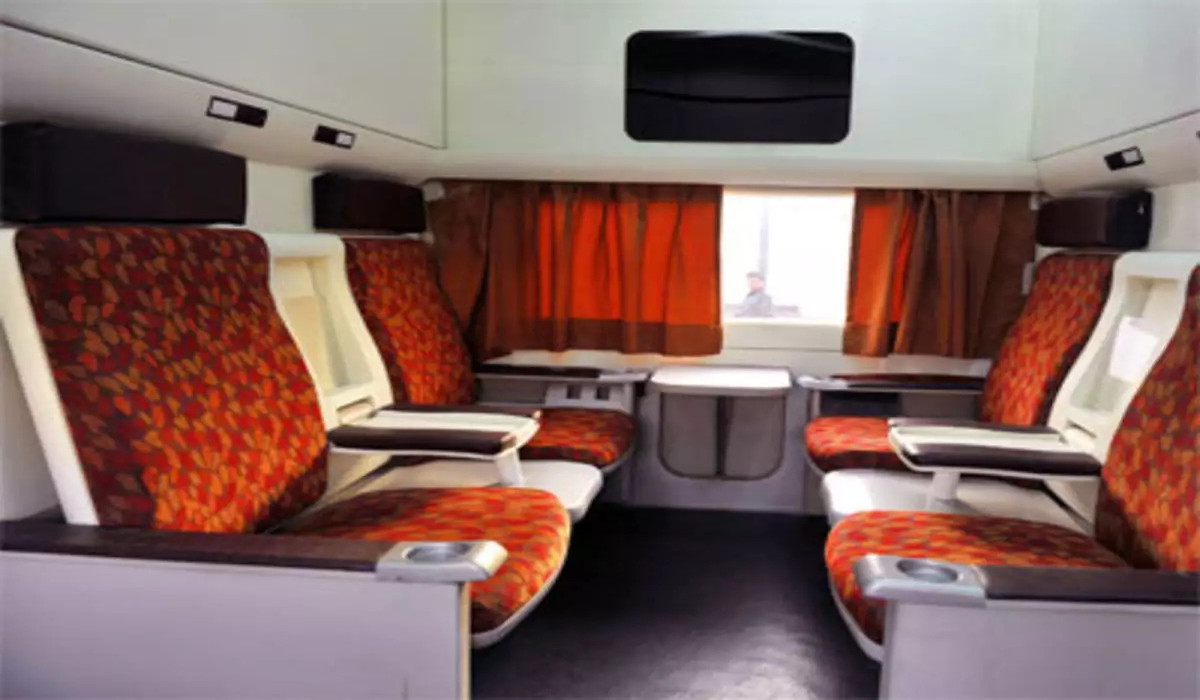
Available on a few Shatabdi Express Trains, you get cushiony executive chairs, tv screens, and leg rests.
Air Conditioned Chair Class (CC)

Great for daytime journeys, CC is air-conditioned and cozy with seats arranged in 2+3 divisions on both sides of the aisles.
Sleeper Class (SL)
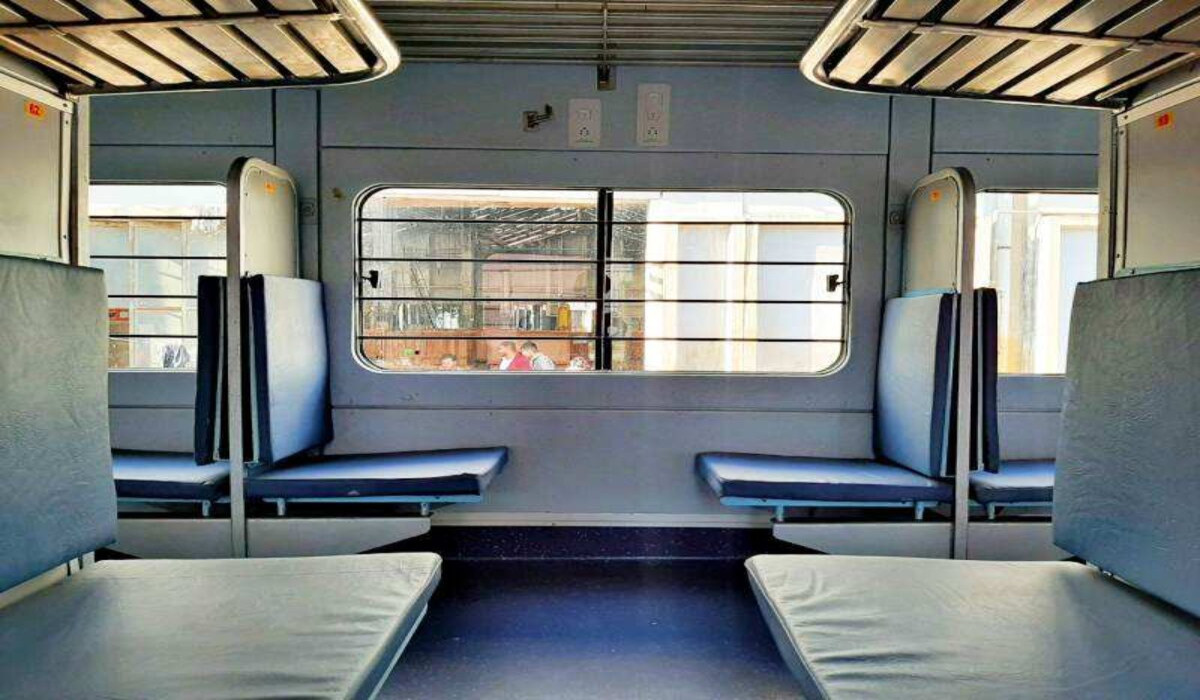
The cheapest and most commonly opted choice of the masses, the SL is found on long-distance trains except the high-end trains like Duronto and Rajdhani.
You do not get any bedding, so you will have to bring your own sleeping bag. The layout is the same as AC3 but there is no air-conditioning or many amenities.
First Class FC

The quaint British Raj era non-air-conditioned FC is gradually disappearing from all trains in India and is now substituted with AC2 on revamped new trains.
Traditional FC consists of sleeper coaches with 4-berth and 2-berth compartments.
2nd Class Seats (2S Reserved or GN Unreserved)

Imagine cars with wooden or plastic seats listed as 2s or GN on the ICRC website. They are obviously not ideal for any long-distance or comfortable travel, but if you are on a tight budget and do not mind roughing it out, it will save you money.
Cost Of Long-Distance Travel
To give you a sense of how much travel in different train classes costs, here are ballpark figures for travel between Mumbai and Delhi which spans 1,400 km (870 miles).
Air Conditioned First Class (1A): 3,500-4,000 INR
Air Conditioned 2-Tier (2A): 2,000-2,500 INR
Air Conditioned 3-Tier (3A): 1,600-1,700 INR
Sleeper Class (SL): 500-600 INR
As you can tell from the rates, train travel is considerably affordable in India for all classes. Paying for train tickets for similar distances in Europe can set you back a few hundred Euros.
Luxury Trains In India
The Palace on Wheels

India’s answer to the uber-luxury Japanese Cruise Train Seven Star, the ‘Palace on Wheels’ is a luxury train unlike any other elsewhere in the country.
Traversing through the Golden Triangle (Delhi, Agra, Jaipur), the ‘Palace on the Wheels’ takes you on an eight-day royal voyage to destinations like Jaipur, Udaipur, Jaisalmer, Jodhpur, Agra, and Delhi.
On this luxurious train, you will discover roomy deluxe cabins, two upscale restaurants serving both local and global dishes, attentive personal butlers, welcoming lounges, a spa, and exceptional 5-star service.
Prices start at 4,046$ for double occupancy in the low season and 8,085$ for double occupancy in the high season (October to March).
The Maharaja Express
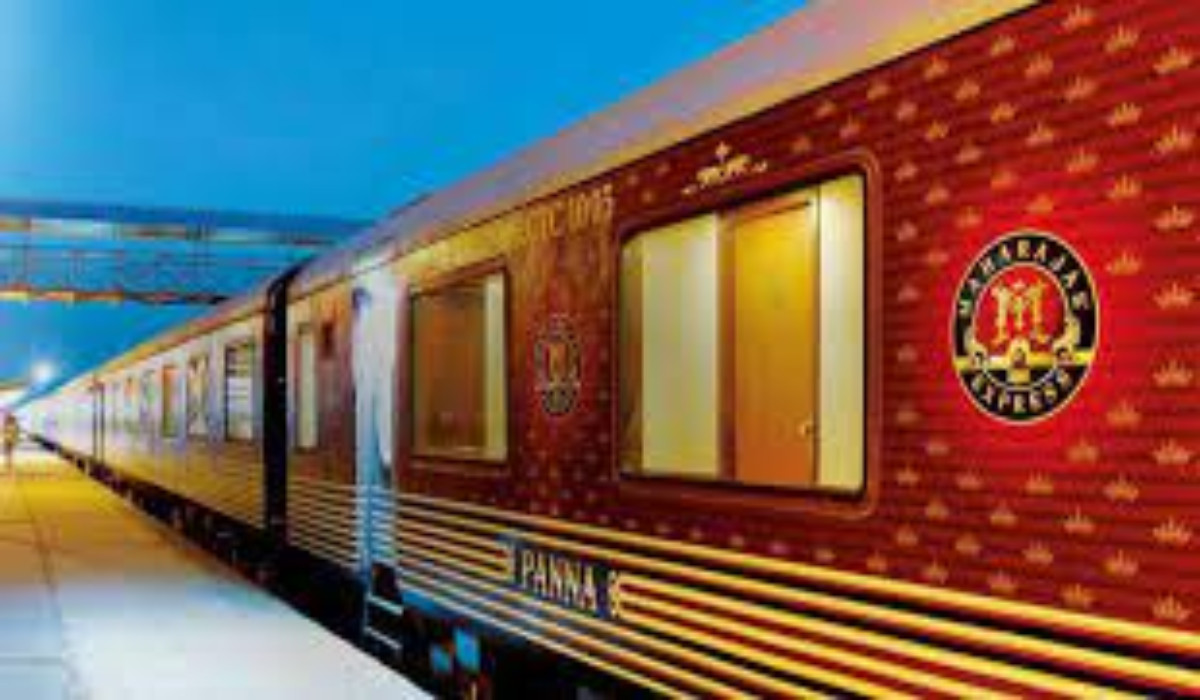
Designed with an aim to serve sophisticated tourists, the Maharaja Express runs on the famous Delhi-Mumbai route with stopovers at Agra, Jaipur, Varanasi, Lucknow, and Khajuraho. Prices start at around 3,500$ per person.
Arguably best luxury train in India, the Maharaja Express is flagship train of IRCTC. It boats round-the-clock valet service, onboard restaurants, complimentary wines, beers, and spirits, spas at premium hotels, guided tours to popular destinations at stopovers, and 24/7 security.
Deccan Odyssey (Mumbai, Goa)

If you are looking to travel in the states of Maharashtra and Goa, check out landmarks in Mumbai, and the UNESCO World Heritage Site Ajanta & Ellora Cave temples in Ahmedabad, and enjoy the perfect beach holiday in the palm-lined white sands of Goa, then the Deccan Odyssey is for you.
Royal Rajasthan on Wheel

The state of Rajasthan— the land of Kings, hospitality, and vibrant culture— in north India is one of the most visited states in India. Royal Rajasthan on Wheels caters perfectly to visitors looking to explore the attractions of the region in style.
It offers 8-day (7-night) itineraries that begin and end in Delhi with stops at Jaipur, Udaipur, Ranthambore National Park, Khajuraho, and Varanasi. Prices start around 4,000$ for two people on sharing.
Golden Chariot
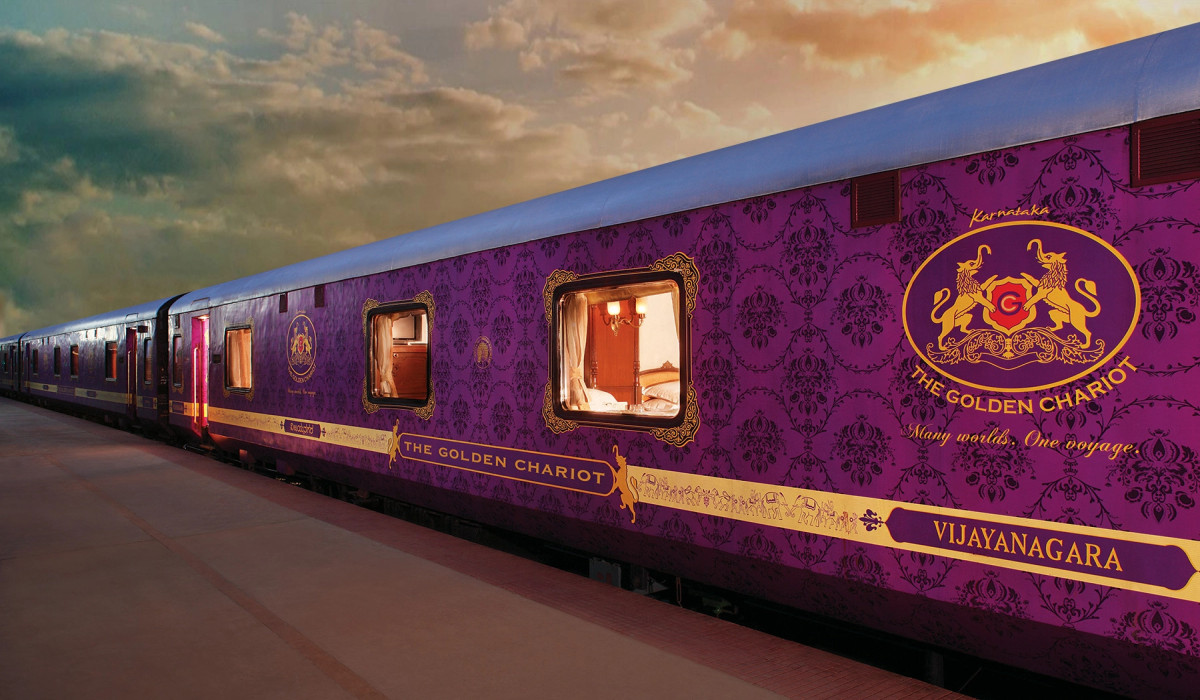
The city of Bangalore is IT hub of India and gets many globetrotting entrepreneurs and IT professionals as visitors from across world.
The Golden Chariot offers week-long itineraries originating from Bangalore to the tropical heaven of Goa and other parts of Southern India.
Indian Maharaja

Operating between Delhi and Mumbai (with stops at Jaipur, Udaipur, Ellora & Ajanta, and Agra) the Indian Maharaja runs during peak tourist season (October to April).
Prices start at 4,000$ for twin sharing and 5,200 for single occupancy for 8-day 7-night itineraries.
Frequently Asked Questions About Train Journeys In India
Is train travel in India worth it?
To truly experience the real India, it is essential to travel extensively on its trains. The train is the best way to witness the splendor and grandeur of India.
India is a subcontinent that is vast and diverse, with a wide range of cultures, landscapes, topographies, colors, sights, and sounds. For those visiting for the first time, it can be challenging to comprehend everything. However, the Indian train is an ideal way to experience the country’s natural, magnificent, and primitive beauty. Trains are the primary mode of transportation in India, and they take you straight to the heart of the action.
Traveling by train in India is a remarkable experience that provides access to breathtaking landscapes and almost all of India’s iconic landmarks. With an extensive railway network, travelers can easily venture to any destination in the country, making it an ideal mode of exploration.
What are the fastest trains in India?
In recent years, the Indian Railways has upgraded many of its Express and Mail trains and added many new services that now run at considerable speed.
-The Vande Bharat Express —which was introduced in 2018 and is commonly known as Train 18—is the fastest train in India which can attain a speed of 110 m/h (180 kp/h). This air-conditioned service runs between New Delhi and Varanasi and features luxurious seats, wi-fi, power outlets, a pantry car, a beverages bar, and excellent onboard service.
-Another fast train that can top a speed of 100 m/h (160km/h) is the Gatimaan Express which runs between Delhi and Jhansi with stops at Agra and Gwalior. The Gatimaan takes less than two hours (departure at 08:10 am and arrival at 9:50 am) to get to Agra from Delhi and is very comfortable for tourists.
-Shatabdi (140km/h – 87 m/h), Rajdhani, and Duronto Express are also modern express trains that operate with German-made Linke Hoffman Busch (LHB) engines. They are known for their reliability, speed, and comfort.
Please note that tickets for high-speed trains like Duronto, Shatabdi, and Vande Bharat often sell out quickly during peak tourist and holiday seasons. Be sure to book your tickets weeks in advance.
What are the most scenic train journeys in India?
The Indian train takes you through vast plains, picturesque mountain ranges, gargantuan deserts, richly populated cities, and dense green jungles. Here is a list of some of the most picturesque rides in India:
-Himalayan Queen (Kalka-Shimla): Operating between the Himalayan hill stations of Shimla and Kalka, the Himalayan Queen takes you through 102 tunnels and bridges with stunning views of the mountains, lakes, and valleys.
-Darjeeling Himalayan Railway (Jalpaiguri-Darjeeling): Popularly known as the “Toy Train,” this train route is considered one of the most in India.
Constructed in 1881, this track spans 55 miles (88km) between Darjeeling and Jalpaiguri and is located at a height of 2,134 (7000 feet). The train takes you through verdant tea gardens, dense forest foliage, sharp bends and loops, and stunning sceneries.
-Jaisalmer-Jodhpur: The so-called “Desert Queen” takes you through the golden Thar Desert with its transcendent beauty and charm.
-Kashmir Railway (Jammu-Udhampur): Passing through 20 tunnels and 158 bridges along the Shivalik mountain ranges, this is the perfect ride into “Paradise on Earth” Kashmir.
Which is the most comfortable train in India for tourists?
There are many uber-luxurious train services in India that offer high-end travel to visitors. Among them are the Palace on Wheels, the Maharaja Express, the Deccan Odyssey, Indian Maharaja, the Golden Chariot, and Royal Rajasthan on Wheels.
They typically offer 3-9 days itineraries covering all the popular tourist regions like Delhi, Rajasthan (Jaipur, Jodhpur, Jaisalmer, Udaipur), Agra, Mumbai, Goa, Kerala, and south India. Prices range from 3,000-4,000$ on a twin-sharing basis during low and shoulder seasons, and 4,000-5,000$ for the peak (November-March) season.
If you are traveling on a lower or mid-end budget, then taking high-speed long-distance travel (with AC1, or AC2) on trains like Shatabdi, Duronto, Rajdhani and Vande Bharat —which are considerably cheaper than European trains—are a great option.
What is the best class on Indian trains?
There are many uber-luxurious train services in India that offer high-end travel to visitors. Among them are the Palace on Wheels, the Maharaja Express, the Deccan Odyssey, Indian Maharaja, the Golden Chariot, and Royal Rajasthan on Wheels.
They typically offer 3-9 days itineraries covering all the popular tourist regions like Delhi, Rajasthan (Jaipur, Jodhpur, Jaisalmer, Udaipur), Agra, Mumbai, Goa, Kerala, and south India. Prices range from 3,000-4,000$ on a twin-sharing basis during low and shoulder seasons, and 4,000-5,000$ for the peak (November-March) season.
If you are traveling on a lower or mid-end budget, then taking high-speed long-distance travel (with AC1, or AC2) on trains like Shatabdi, Duronto, Rajdhani and Vande Bharat —which are considerably cheaper than European trains—are a great option.
Can foreigners book a ticket on an Indian train from outside of India?
Yes, you can book a ticket before you travel to India. The way to do it is to register yourself at the IRCTC (Indian Railway Catering and Tourism Corporation) with a foreign mobile number and purchase from the website directly.
Usually, the website accepts foreign debit and credit cards but some international tourists have occasionally reported having problems getting their payment processed.
There is, however, another option that is handy for foreign tourists. You can book your travel to many popular tourist destinations using 12Go Asia ( www.12go.asia) website which provides booking services for many countries in South and South East Asia.
You do not have to register at the ICRTC website for purchasing a ticket through 12Go Asia, and all international credit cards are readily accepted by them.
Are Indian trains safe for solo female travelers?
High-end Indian trains like Duronto, Shatabdi, and Rajdhani are generally very safe for female travelers, even if they are going solo.
The local regional trains, which are usually very crowded and make frequent stopovers, are obviously not recommended if you are traveling solo or long distance.
However, there are certain precautions that you need to take to stay safe.
-Avoid arriving in or departing to unfamiliar places late at night.
-Prefer traveling in better classes like AC1, 2AC, or 3AC. Avoid traveling by Non AC sleeper cars.
-Dress modestly so you won’t attract too much attention.
How hygienic and safe is the food on Indian trains?
The better classes on trains like Shatabdi, Duronto, and Rajdhani offer onboard snacks and refreshments which are covered in the fare.
These are generally safe to eat. But if you have a dodgy stomach, or if you are new to India and haven’t acclimatized yet, you would be better off packing your snacks and drinks.
How punctual are the Indian trains? Do they run late?
In general, the local and regional trains may run late but most good quality modern high-speed trains like Shatabdi, Duronto, Vande Bharat, and Rajdhani that run between major cities like Mumbai, Delhi, Goa, Jaipur, and Kolkata run on time, and follow strict pre-announced schedules.
What are some handy Indian train travel tips?
Here are some useful tips for train travel in India:
- Follow the safety guidelines issued by the railway authorities. You will find them on the IRCTC website and on the trains.
- Don’t stick your head out of the window.
- Do not leave your belongings unattended.
- Women can book their tickets in special ladies’ coaches or travel in high-end express trains for extra safety.
- Be aware of pickpockets in crowded railway stations. Keep your valuable well-strapped. Invest in better anti-theft backpacks.
- Be extra vigilant if you are traveling by non-AC sleeper cells, which are overcrowded and open.
- Be cautious of strangers offering you food or rides.
- Carry your own bottle of water and snacks.
What is a Taktal Ticket and how can it help me?
Taktal tickets are pricier tickets (30% of the normal ticket price) that are reserved as an emergency quota of tickets. They are open to booking 10 am the day before the departure of the train for both AC and non-AC classes. They are available at the train stations where the trains are scheduled to depart from, but there are likely going to be long queues, so you will have to get to the station early.
How much does a First-class train ticket cost in India?
How much a first-class ticket (AC1) costs may depend on the length of your journey and the time of the year you are traveling in.
Here is a break-down of estimated costs for express and mail services:
1-300Km: 998 INR (for “Lean season”) and 1059 INR for (“Peak season”)
600 km: 1,946 INR ( lean season) and 2,037 (peak season)
900km: 2,593 INR (lean Season) and 2,756 INR (peak season)
1200km: 3,144 INR (lean season) and 3,327 INR (peak season)
1500km: 3,641 INR (lean season) and 3,848 INR (peak season)
As you can see, the price of the ticket goes up with the increase in distance.
What is the cost of a “sleeper” train ticket in India?
The so-called sleeper class is the low-budget class of travel on Indian trains. All you get is an open sleeping berth in an 8-berth compartment with barely any padding. There is no air conditioning inside the cars, enough ventilation for air to pass. Each coach has 72-80 sleeper seats. They are the cheapest tickets you can buy.
Regional railways set their own rates for sleeper coaches, but they cost as little as 120 INR for a journey of 200km.
What is the cost of a luxury train ticket in India?
-The Palace on Wheels: For 7-Nights, 8 Days Tour 8,085$ for single occupancy, and 5,257$ on Twin sharing in peak season.
In lean season the cost for the same itinerary is 6,615 for single occupancy and 4,046$ for twin sharing.
-Maharaja Express: Prices start at $ 7,750 for Deluxe Cabin for 7 days/6 night tours and $8,950 for Junior Suite
–Deccan Odyssey: For a 7 nights/8 days tour tariffs start at $8,330 for single occupancy in deluxe cabins and $11,900 for twin sharing/double occupancy.
–Royal Rajasthan on Wheels: Prices for 7 Nights packages start at $ 6,055 for single occupancy and $ 9,100 for double occupancy.
What is the most expensive train tour in India?
The Maharaja Express is by far the most expensive luxury train service in India.
Are Indian trains children-friendly? Can kids travel for free on Indian trains?
Yes, Indian trains are very safe and kid-friendly. Just make sure you book your travel on good quality long-distance trains like Shatabdi, Duronto, Rajdhani, and Vande Bharat, and select better air-conditioned classes for extra comfort and privacy.
Trains like Vande Bharat have onboard changing tables, washbasins, water supplies for mothers taking care of infants, and games like “Snakes and Ladders” for children.
You do not have to buy a ticket for a child that is less than 5 years of age. For children between the age of 5 and 12, the cost for a ticket is half the price for an adult, whereas children above the age of 12 will need a full ticket to board.
What are Waitlist (WL) Tickets?
These are the tickets that become available for purchase only if previously booked tickets are canceled by passengers due to a last-minute change of plans. In most cases, you will get a seat hours before the departure time, but if you do not, your money will be refunded to you.
What should I carry while traveling on Indian trains?
Basic amenities like soap, toilet paper, and towels are available on board major train services, but it is not a bad idea to carry your own amenities just in case.
How do I know where to get off a train?
There are usually no announcements but all air-conditioned classes have attendants and staff who inform you ahead of time before your destination arrives, against a small tip.
How do I find my platform?
Indian Railways Train Platform Locator helps you find your exact arrival platform for any train at any station.
https://indianrailways.info/platform_locator/
All you need to do is enter your train name and number in the search boxes on the above link and you should be able to locate your platform.
You can also call Railway helpline 139 to ask.
 Skip to main content
Skip to footer
Skip to main content
Skip to footer




